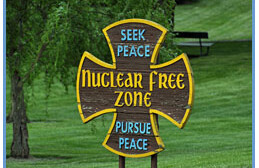Caitlin Tierney is the latest in a group of highly talented young people we
have been fortunate to employ as interns at the Carnegie Council. Working in the
program on U.S. Global Engagement, she has prepared this most timely essay on
a topic of enduring interest to the Council, and, more broadly, to the global
discussion on the future of "getting to zero" on nuclear weapons.
Nuclear proliferation has become one of the defining problems of our time and
will most likely be a policy issue for many generations to come. The threat of
all-out nuclear war does not appear to be on the near horizon, but as more countries
have the desire for and the capabilities to create nuclear weapons, it is ever
more important for states to determine a way to create nuclear-weapon-free
zones (NWFZs) in the pursuit of a nuclear-weapon-free world. These NWFZs are
regionally initiated and genuinely desired, but sadly, the reservations of the
nuclear weapon states, specifically those of the United States, hinder the success
and complete denuclearization of these designated zones.
NWFZs ultimately achieve both regional and international security, while also
strengthening the nuclear nonproliferation regime. The 1999
UN Disarmament Commission report on the establishment of nuclear-weapon-free
zones categorized the objectives and purposes of NWFZs into two overarching categories:
- To enhance the security of those states within the designated zone; and
The creation of nuclear-weapon-free zones is one of the many tools that have
contributed to controlling the spread of WMDs and of nuclear proliferation.
It should be considered as one of the most crucial steps that must be taken
in order to obtain a nuclear-weapon-free world. Establishing NWFZs contributes
to the strengthening of regional security while building confidence among participating
states by promoting cooperation on peaceful uses of nuclear energy and on nuclear
safety and security, as well as on environmental problems related to nuclear
materials, facilities, and activities. These NWFZ treaties also complement the
work of the Nuclear
Non-Proliferation Treaty (NPT), prohibiting the deployment of nuclear weapons
possessed by the five
nuclear weapon states (NWS) inside the designated zone, a requirement not
made in the NPT. Moreover, a significant benefit of NWFZ treaties is obtaining
negative security assurances from the NWS, something that is not guaranteed
within the NPT treaty because of the NPT's pro-NWS stance.
Today there exist five regional NWFZ treaties: the Treaty of Tlatelolco (Latin America and the Caribbean); the Treaty of Rarotonga (South Pacific); the Treaty of Bangkok (Southeast Asia); the Treaty of Pelindaba (Africa); and the Central Asian Nuclear Weapon Free Zone Treaty. In addition, proposals have been made for NWFZs in South Asia, which would include the non-NPT signatory nuclear powers India and Pakistan; the Middle East, which would include the controversial states of Iran and Israel; the entire Southern Hemisphere; Northeast Asia, which would include North Korea; and Central and Eastern Europe. However, because of the unwillingness of certain states within these designated regions, as well as the sentiments of the NWS, negotiations on these NWFZ treaties have yet to be initiated.
The success of NWFZ treaties, however, only comes through the endorsement and
ratification of the additional protocols by the NWS. Each treaty has varying
requirements in its protocols, which ultimately affects the ratification by
the NWS; but they all encompass three main components:
- The nuclear weapon states must provide negative security assurances to the regional parties, which includes a commitment to refrain from the use of, or the threat of using, nuclear weapons against the designated states;
Although the NWS support the treaties in theory, of the five existing NWFZ
treaties, the Treaty of Tlatelolco is the only one which has actually had its
Protocols signed and ratified by all five of the NWS. This lack of success for
the others is for two main reasons:
- Certain NWS states wish to continue to support nuclear programs (testing and/or development) within the designated zones.
The South Pacific NWFZ treaty is an example. Its Protocols require the complete
denuclearization of the region, which would prevent the U.S. from navigating its
naval nuclear submarines through the zone; therefore the U.S. refuses to ratify
the Protocol. The United States remains the main NWS to have objections to all
these treaties' Protocols, preventing successful nuclear nonproliferation.
Even so, there is widespread agreement that NWFZ treaties have contributed towards restricting the spread of nuclear weapons and created norms for nuclear disarmament. The 2000 NPT Review Conference reaffirmed that the establishment of internationally recognized nuclear-weapon-free zones, on the basis that these arrangements were freely arrived at by the states within the designated zone, enhances global peace in addition to regional peace and stability.
The creation of the five existing NWFZs has shown the commitment by the majority of countries in the world not to acquire nuclear weapons. Although this movement is gradual and slow, the establishment of NWFZs contributes to a more peaceful and secure world. NWFZs continue to be an important tool for strengthening the international nonproliferation regime, achieving the ultimate goal of nuclear disarmament outlined in Article VI of the NPT, and building international peace and security. Promoting the establishment of new NWFZs and the expansion of the existing zones will be an important step toward the goal of a world free of nuclear weapons.
On May 28, 2010, the United Nations NPT Review Conference came to a conclusion in New York City. One of the major conclusions of this particular review conference was the proposal of a Middle East NWFZ Conference in 2012. As can be seen from the existing NWFZ treaties, ratification of the Protocols by the NWS is significant to the success of these treaties in becoming completely nuclear-free. Therefore, the parties to the NWFZ treaty of the Middle East and the NWS need to come to a compromise on the requirements within the additional protocols for the treaty to have a chance at successfully removing nuclear weapons from the region.
The combination of political conflicts and suspected nuclear programs in the Middle East is a recipe for nuclear weapon proliferation in the region. Yet although all Middle Eastern countries are in favor of an NWFZ in theory, until they are guaranteed that their regional competitors are free of nuclear weapons, they refuse to give up their "right" to possess them. Even so, there have been efforts to establish a nuclear-weapon-free zone as far back as 1974, when Iran, supported by Egypt, raised the issue in the UN General Assembly. Since then, the UN General Assembly has adopted a resolution every year recommending the establishment of a nuclear-weapon-free zone in the Middle East. Since 1980, this annual resolution has been adopted by consensus, including the support of all Arab states, Iran, and Israel. In 1990, President Mubarak of Egypt proposed the establishment of a zone free of weapons of mass destruction in the Middle East. The proposal was not intended to replace the earlier idea of a nuclear-weapon-free zone in the area but rather to be pursued as a complement to the earlier proposal.3
Today, the expansion of the Middle East zone concept to include all weapons of mass destruction, as well as their means of delivery, has been politically accepted both by the countries within the Middle East and by the nuclear weapon states. In May 1995, the Review and Extension Conference of the NPT parties adopted a resolution on the Middle East recognizing that the current peace process contributes to a Middle East zone free of nuclear weapons as well as other weapons of mass destruction. It also called upon all states in the Middle East to take practical steps towards establishing an effectively verifiable Middle East zone free of nuclear, chemical, and biological weapons, in addition to weapons of mass destruction.4
The main obstacle to the establishment of the Middle East NWFZ is the compliance
of Iran and Israel, since they are already suspected of holding small, yet deadly,
nuclear arsenals. At the NPT Review Conference held in May 2010, just as with
the existing NWFZs, all five of the nuclear powers were in support of such a
treaty. However, because of their reservations about Iran and Israel, the question
remains whether or not the United States will ultimately ratify the Protocols.
Whether or not the Middle East will create an NWFZ, we have seen that there is
actual movement towards one. In 2012 there will be a conference among the states
in the region to create a draft treaty. However, the NWS will have reservations
to the proposed protocols, as they have had with the existing NWFZ treaties.
Most likely, the United States will not sign or ratify a negative assurance
protocol in regards to Iran. As long as there is still the possibility for the
states in the region to launch nuclear weapons from bases already in existence,
the United States will refuse to ratify, just as was the case for the Treaty
of Pelindaba in regards to Libya.
However, despite these reservations, there has been slow but gradual progress towards regional nonproliferation. There is widespread agreement among all countries that the nuclear-weapon-free zone treaties—even though four out of five remain unratified—have contributed towards nuclear nonproliferation and created norms for nuclear disarmament along with the NPT.
The creation of the five existing nuclear-weapon-free zones has shown the commitment
by most of the international community to not acquire nuclear weapons, but to
pursue peaceful uses for nuclear technology that will benefit all, while maintaining
peace and security. These treaties will continue to be an important tool for
the goal of nuclear disarmament and in building international peace in general.
Achieving a world free of nuclear weapons and WMD with the expansion of these
zones is an important step, but the ultimate success of these treaties can only
be reached with the ratification of the protocols by the nuclear weapon states.
This may not occur in the immediate future, but it is imperative in order to
realize a world free of nuclear fears.
NOTES
1
"NTI:
NWFZ Tutorial." Nuclear Threat Initiative website.
2
"NTI:
NWFZ Tutorial." Nuclear Threat Initiative website.
3
Said, Mohammed K. "Middle
East Weapons of Mass Destruction Free Zone: Regional Security and Non-Proliferation
Issues." UNIDIR, 2004.
4 Ibid.



